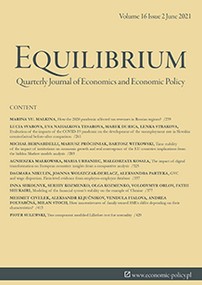How the 2020 pandemic affected tax revenues in Russian regions?
How the 2020 pandemic affected tax revenues in Russian regions?
Author(s): Marina Yuryevna MalkinaSubject(s): National Economy, Regional Geography, Economic policy, Health and medicine and law, Fiscal Politics / Budgeting
Published by: Instytut Badań Gospodarczych
Keywords: 2020 pandemic; tax revenues; region; resilience; factors;
Summary/Abstract: Research background: The 2020 pandemic has proven to be stressful for regional tax systems. However, these systems reacted differently to lockdown and a decline in business activity, which was associated with both their structures and the specifics of their development. Purpose of the article: The aim of the article is to assess the impact of the 2020 pandemic on tax revenues of Russian regions, as well as to analyze the factors contributing to the resilience of regional tax systems to epidemiological crises. Methods: The study is based on monthly data from the Federal Tax Service of the Russian Federation on total tax revenues in 83 Russian regions for 2013–2020. For data up to March 2020, we construct stationary time series and plotted ARiMA regressions. Based on them, we forecast tax revenues for the period from April to December 2020, if there were no pandemic. The impact of the pandemic is calculated as the deviation of actual tax revenue from the forecast for the corresponding 9 months. Findings & value added: We find that the impact of the pandemic on tax revenues varies over time and space. The crisis hit the fiscal system most negatively in the first three full months of the lockdown (April–June 2020). Some mining regions of the Urals, Western and Eastern Siberia, specializing in the extraction of oil and gas, as well as non-ferrous metals, turned out to be the most vulnerable to the pandemic. The most resistant to it are the central and southern regions of the European part of Russia. Calculation of Pearson's correlations shows that the greatest drop in tax revenues occur in regions with a larger share of the mining industry in gross value added and MET in tax revenues, with a higher GRP per capita and an increased level of general economic instability. The smallest decline in tax revenue, or even its growth, is observed in regions with a larger share of personal income tax and property tax in tax revenues, a higher share of trade and processing industries, social sphere and public administration in gross value added, a higher degree of economic diversification and a larger share of small business in total turnover. The obtained results are applicable to manage the resilience of tax systems to epidemiological crises.
Journal: Equilibrium. Quarterly Journal of Economics and Economic Policy
- Issue Year: 16/2021
- Issue No: 2
- Page Range: 239-260
- Page Count: 22
- Language: English

